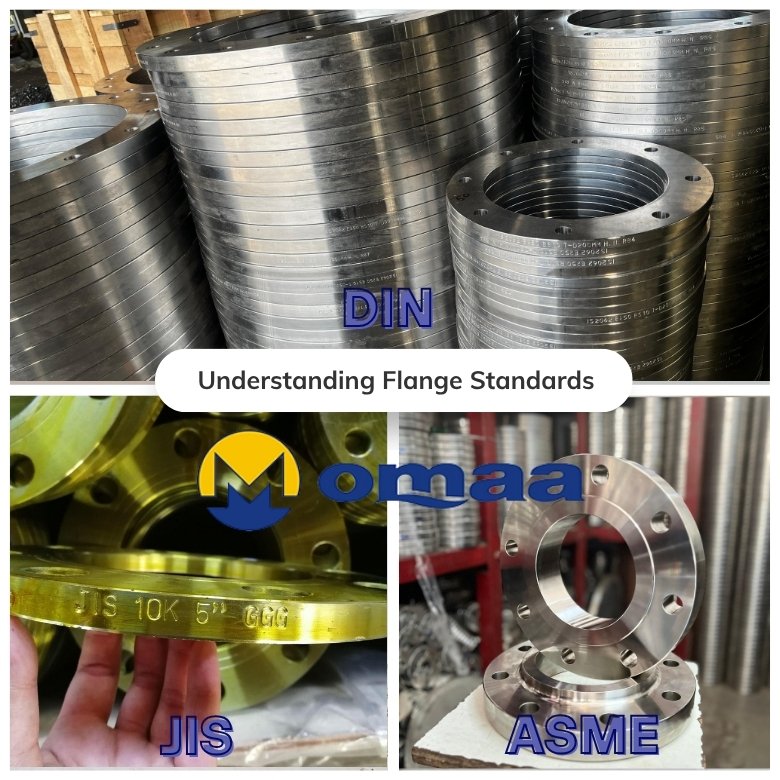Flanges are a critical component in piping systems, serving as the connecting point for valves, pipes, pumps, and other equipment. When it comes to selecting the right flange, understanding international flange standards is essential to ensure compatibility, safety, and performance. In this blog, we’ll explore and compare the most widely used flange standards: ANSI, ASME, DIN, EN, and JIS — helping you make informed decisions for your projects.
What Are Flange Standards?
Flange standards are sets of technical specifications that define the dimensions, tolerances, pressure ratings, and materials used for manufacturing flanges. These standards ensure interchangeability, uniformity, and safety in piping systems across industries such as oil & gas, chemical, power, water treatment, and marine.
Major Flange Standards: A Global Overview
| Standard | Origin | Governing Body | Common Use |
|---|---|---|---|
| ANSI / ASME | USA | ASME (American Society of Mechanical Engineers) | North America, Global projects |
| DIN | Germany | Deutsches Institut für Normung | Europe, Middle East |
| EN | Europe | CEN (European Committee for Standardization) | EU & UK |
| JIS | Japan | Japanese Industrial Standards | Japan, Southeast Asia |
ASME / ANSI Flange Standards
ASME B16.5 and ASME B16.47 are the most commonly used American flange standards.
- ASME B16.5 covers flanges from ½ inch to 24 inches.
- ASME B16.47 covers 26 inches to 60 inches.
- These standards include pressure ratings from Class 150 to Class 2500.
Key Features:
- Based on pressure-temperature ratings.
- Widely accepted in oil & gas, petrochemical, and power industries.
- Used in both forged steel and cast steel flanges.
DIN Flange Standards
DIN (Deutsches Institut für Normung) standards are older European specifications used widely in Germany and neighboring countries. Common DIN standards include:
- DIN 2633: Weld neck flange, PN16.
- DIN 2576: Slip-on flange, PN10.
Key Features:
- PN (Pressure Nominale) rated, e.g., PN6, PN10, PN16.
- Precise dimensional tolerances.
- Being gradually replaced by EN standards in the EU.
EN Flange Standards (EN 1092-1)
EN 1092-1 is the current European standard replacing many older DIN standards.
It standardizes flange types like:
- Type 01 – Plate flange.
- Type 11 – Weld neck flange.
- Type 13 – Loose flange with welding neck.
Key Features:
- Rated by PN pressure classes (PN6 to PN100).
- Used in EU-compliant projects, particularly in water, HVAC, and food industries.
- Requires CE marking under PED (Pressure Equipment Directive).
JIS Flange Standards
JIS B2220 is the primary standard for flanges in Japan.
Flange types include:
- • JIS 5K, 10K, 16K, 20K, and 30K
(The “K” stands for kg/cm² pressure rating)
Key Features:
- Common in Asian markets and Japanese equipment.
- Designed for both metric and Japanese piping dimensions.
- Limited use in global applications unless tied to Japanese-origin equipment.
Comparison Table: ANSI vs ASME vs DIN vs EN vs JIS
| Feature | ASME/ANSI | DIN | EN | JIS |
|---|---|---|---|---|
| Pressure Rating | Class 150–2500 | PN6–PN100 | PN6–PN100 | 5K–30K |
| Unit System | Imperial (inch) | Metric (mm) | Metric (mm) | Metric (mm) |
| Global Use | High | Moderate | High (EU) | Regional (Asia) |
| Common Industries | Oil & Gas, Power | Water, Mechanical | HVAC, Food, Pharma | Shipbuilding |
Choosing the Right Flange Standard
Here are 5 tips to help you choose the correct flange standard for your application:
- Check project specifications – Always follow the engineering or EPC requirements.
- Consider geographic region – Use regional standards for better availability and support.
- Match pipe and flange standards – Avoid mixing metric and imperial systems.
- Verify pressure and temperature ratings – Safety first.
- Ensure compliance and certification – Especially for CE (EN) and PED requirements.
Final Thoughts
Understanding flange standards like ANSI, ASME, DIN, EN, and JIS is crucial for engineers, procurement specialists, and project managers. Choosing the correct flange specification not only ensures a leak-proof and durable connection but also saves time and cost during installation and maintenance.
At Omaa, we supply high-quality flanges as per global standards. Whether you’re sourcing for offshore oil rigs, industrial pipelines, or utility networks — we’ve got the right flange for you.
Need Help Choosing the Right Flange?
Contact our experts at:
sales@omaaforged.com | www.omaaforged.com
Let us help you find the best solution based on your industry and region.
